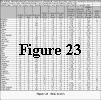 Political Risk
Political RiskRISKS
An International Country Risk Guide (ICRG)
11, put out by a U.S. division of International Business Communications Ltd. of London, presented individual ratings for political, financial, and economic risk.Political risk includes the risk of political change and the risk of adverse political action. Political change is when the government changes through vote of the electorate, death of political leaders, or overthrow of the government. Political change can be positive or negative. On one hand it can accelerate the positive trends described beforehand. On the other hand, it can result in a change to a more repressive government or changes in government policies that are detrimental to the business environment.
Examples of political actions that can be detrimental include:
| involvement in wars, | |
| expropriation of property, | |
| implementation of embargoes, | |
| establishment of quota, tariffs, and administrative barriers to trade | |
| establishment of import or export controls | |
| establishment of restrictions on taking currency or profits out of the country | |
| establishment of new regulations regarding business operations or product standards, |
Evolutionary political change happens through the election process. These changes can often be anticipated and monitored. Sudden political changes tend to be more dramatic and have a larger impact on a nation and its policies. Nations with low political freedom or whose populace is suffering do to a low standard of living, high employment, or high inflation are prime candidates for sudden or dramatic political change.
The threat of political action is inherent in all countries. The industrialized countries have a history of ever increasing the regulatory burden on business. This tends to be an evolutionary process. More important is dramatic and sudden political actions taken by nations usually in desperation and usually in ill-advised attempts to solve fundamental problems such as high unemployment or high inflation.
Economic Risk
The rates at which currencies can be exchanged between nations vary. Some currency values float based on supply and demand; others are tied to the currencies of other nations. Currencies that float increase or decrease in value depending on the balance of payments with other nations, the attractiveness of investments within the country, the prevailing interest rate on debt securities, and the confidence of investors and traders in the nations currency and future.
Currencies whose value is tied to the value of other currencies are subject to devaluation by the nationís government. Devaluation can be advantageous or disadvantageous to individual firms depending on their financing and their cost structure with respect to global markets. Devaluation can reduce the price of exports on the global market making them more competitive. However, in general, investors have not treated equities in countries that have devalued currencies kindly. Investors consider devaluation to represent an unwillingness or inability of a nation to stand behind its commitments. In addition the devaluation creates an uncertainty about values of assets, liabilities, and income streams. Devaluation may add to inflationary pressures and raise the risk that local companies that borrowed dollars and other major currencies could go bankrupt. Shares of Mexico Fund dropped from a high of $36.00 in late 1984, to a value of around $12.00 as a result of the 1994 Mexican peso devaluation. It is slowly recovering but is at only $18.00 two and a half years later.
According to a recent article in the Financial Times, emerging market currencies are currently coming under attack.
12 The article cited recent devaluationís of the Czech Koruna and the Thai Bhat. Investors were borrowing yen at low Japanese rates of .5% and buying high yielding currencies. In May, when investors thought that Japan would raise interest rates, they repaid loans and sold high yielding currencies, precipitating the pressure on the Koruna and the Baht. The article said that the South African Rand, the Philippine peso and the Polish Zhoty, were under attack. Brazilís Real also looks overvalued given Brazilís large current account deficit. Currencies with fixed exchange rates are in the most trouble. The fixed exchange rate prevents central banks from reacting flexibly to attacks. A large current account deficit is the most reliable sign that a currency is in trouble.In addition to exchange rate risk, investors and business run the risk of convertibility restrictions. The nation may not allow profits to be taken out of the country or may have restrictions on the removal of currency from the country.
Inflation rate is a good indicator of risk that a countryís currency will devalue, be devalued, or that a country will invoke convertibility restrictions.
![]()
![]()